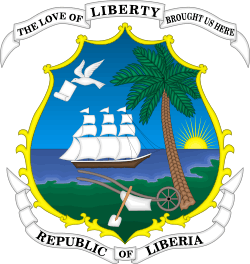Administrative divisions of Liberia

Liberia is divided into fifteen counties, which, in turn, are subdivided into a total of 90 districts and further subdivided into clans.
After independence in 1847, Liberia was divided into five counties - Grand Cape Mount, Montserrado, Grand Bassa, Sinoe, and Maryland Counties extending along the coast.[1] The remaining area upcountry was administered by Americo-Liberian district commissioners. In 1964, under President William Tubman's 'Unification' policy, the three inland provinces were disestablished, and all the inland administrative divisions converted into counties: Grand Gedeh, Nimba, Bong, and Lofa.
In 1984, under Samuel Doe, Grand Kru and Bomi counties were established. In 1985, two more counties were created: Margibi and River Cess. The last two current counties were created under Charles Taylor: River Gee in 2000 and Gbarpolu in 2001.
Governance
 |
|---|
| This article is part of a series on the politics and government of Liberia |
|
Executive |
|
Judiciary |
The fifteen counties are administered by superintendents appointed by the president. The Constitution calls for the election of various chiefs at the county and local level. These elections have not taken place since 1985 due to war and financial constraints.[2]
Counties
There are 15 counties in Liberia.
| # | County | Capital | Established | Area (km2) | Population (2008 Census) |
|---|---|---|---|---|---|
| 1 | Tubmanburg | 1984 | 1,932 | 84,119 | |
| 2 | Gbarnga | 1964 | 8,754 | 333,481 | |
| 3 | Bopulu | 2001 | 9,953 | 83,388 | |
| 4 | Buchanan | 1847 | 7,814 | 221,693 | |
| 5 | Robertsport | 1856 | 4,781 | 127,076 | |
| 6 | Zwedru | 1964 | 10,855 | 125,258 | |
| 7 | Barclayville | 1984 | 3,895 | 57,913 | |
| 8 | Voinjama | 1964 | 9,982 | 276,863 | |
| 9 | Kakata | 1985 | 2,691 | 209,923 | |
| 10 | Harper | 1857 | 2,297 | 135,938 | |
| 11 | Bensonville | 1847 | 1,880 | 1,118,241 | |
| 12 | Sanniquellie | 1964 | 11,551 | 462,026 | |
| 13 | Rivercess | 1985 | 5,564 | 71,509 | |
| 14 | Fish Town | 2000 | 5,113 | 66,789 | |
| 15 | Greenville | 1847 | 9,764 | 102,391 | |
Districts
Clans

Clans of Liberia were local political units created as part of an effort to extend influence to the hinterland of the country. [3]The first tier of administrative government, beneath districts of Liberia, the clan structure only loosely corresponded to traditional local political groupings. Clans were legally recognized through legislation in 1905 and 1912. [4] In a number of cases the clans, each under a chief, were combined under larger units called chiefdoms and headed by a paramount chief. [3] Clans and chiefdoms were in some cases parts of a limited number of recognized tribes. [3] Indigenous Africans were regarded as corporate members of their respective groups rather than as individual citizens of Liberia. Clan land was owned communally and could be alienated only with the agreement of the chiefs. [3] The units of clans and chiefdoms gradually merged into the state. The County Council, affirmed in the Budget Act of 2012, replaced informal town hall meetings and includes a broad representation of citizen groups, districts, chiefdoms and clans.[4]
See also
References
- ↑ "Decentralization Of Political & Administrative Power In Liberia". www.theperspective.org. Retrieved 2017-01-03.
- ↑ "Liberia cannot afford local polls". BBC News. January 14, 2008.
- 1 2 3 4 "Indirect Rule in the Hinterland". GlobalSecurity.org. February 2012. Retrieved 13 June 2012.
- 1 2 Nyei, Ibrahim. "Decentralizing the State in Liberia: The Issues, Progress and Challenges". Stability:International Journal of Security & Development. 3. doi:10.5334/sta.eg. Retrieved 16 October 2015.